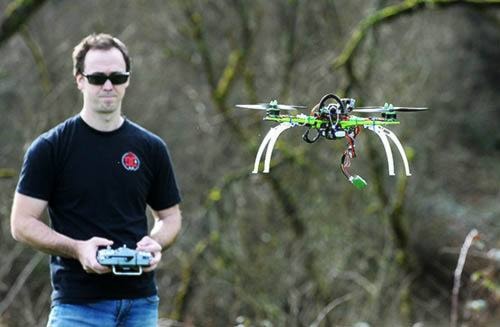In the blink of an eye and the flip of a switch, for a few hundred dollars, anyone can enter the drone’s world.
First, it takes some hours of hands-on flying, when the hobbyist works the remote controls and learns how to fly a model airplane, and what earth looks like a few hundred metres up in the sky.
Once you can do that, responsibly and competently, it’s time sit down and strap on the goggles.
That’s when you learn what it’s like to be a drone.
With the live video feed from the drone’s camera showing on the goggles, drone pilots enter another world.
You have to sit down when doing so because you can get dizzy following the flight path and the sharp turns and dizzying ascents and descents.
It’s called first-person view, and it’s the latest trend in the hobby world of radio-controlled aircraft.
Flying a model without video “gets old really quickly,” says hobbyist Jonathan Reichert.
“Then you put the goggles on you see all kinds of really cool stuff.
“I put the goggles on and started creeping into the trees, oh man, it’s an unreal experience.”
Flying with first-person view, or video piloting, allows close-up views of objects that a ground-bound pilot could never hope to see.

One time, Reichert was able to hover up to an eagle in a tree-top for a close-up view.
In another recent video he posted on his YouTube channel, he flew his drone above fog patches to capture awesome shots of Maple Ridge scenery.
And with the advantage of live video feed, it’s much easier to judge depth perception and avoid crashing into objects.
Reichert has been flying remote control model airplanes for about four years and has about 20 planes.
He now has two drones, too. But still splits his time equally between the airplanes and drones.
One of his favourite model airplanes is a DC-3, decked out in wartime colours as used during the D-Day invasion in June 1944.
Another is favourite is a model of a Super Cub Bush Plane.
“The full-sized ones can land on the tops of mountains.”
He’s only been flying drones, which zip around in any direction, up and down, forwards and backwards, like a UFO, for about a year.
One of his two drones is a quad-copter, in the 450 category, an alien-looking contraption that has four motors that separately power four carbon-fibre propellers.
The central processing unit decides how much power goes to each engine, which controls direction. The remote control device controls the computer.
There are few moving parts.
“What you see is what you get,” Reichert says.
With the radio and drone combined, the total cost for a beginner is about $500.
Reichert says the drone’s range is about 40 kilometres, using video piloting.
Doubling up on the battery pack can increase flying time to about 18 minutes.
Attaching a gimble to the underside can allow him to use a Go-Pro video camera for greater picture quality.
The hobby’s low costs could be why many pilots crash their drones by overflying their abilities before mastering the basics.
Drone models were one of the hottest items this Christmas, which leads to “thousands of people crashing them on Christmas day.”
While there are no laws yet regulating drone flying, Reichert follows Transport Canada guidelines, which require drones to keep at least 150 metres from buildings, cars or people.
That’s why he does his flying in quiet areas, such as over Kanaka Creek Regional Park.
However, after getting all the required approvals, he did take to the air during Maple Ridge’s birthday celebrations last summer to record the celebrations from above.
Most people didn’t even know the drone was there.
Responsible flying is the key, he says. He’d never bring his drone close to a building, auto or person, for privacy and safety reasons.
Should a hiker encounter his drone on a trail buzzing nearby, “you’d have right to punch it out of the air and smash it to pieces.”
